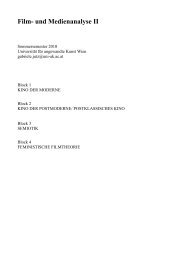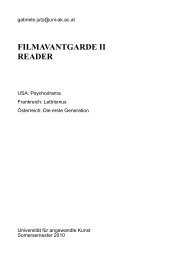Filmanalyse - Gabriele Jutz
Filmanalyse - Gabriele Jutz
Filmanalyse - Gabriele Jutz
Create successful ePaper yourself
Turn your PDF publications into a flip-book with our unique Google optimized e-Paper software.
That smell never left me, and many years after the event I found myself asking an<br />
expert in perfumes how I could reconstruct the memory of that fateful scent. The<br />
perfume industry has a specialised technician - he is called "the nose", and is one<br />
of the best-paid figures in this mysterious and highly remunerative industry - and<br />
it was one of those experts whom I asked how I could recreate the perfume of<br />
nitrate film. Like all "noses", the person I contacted for this purpose was very<br />
secretive about how he managed it, but he did bring me a tiny bottle with an essence<br />
whose smell was indeed that smell, my first epiphany of nitrate.<br />
Camphor, cinnamon, neroli, the essence derived from the pineal gland of an owl -<br />
these and many other scents were mentioned, but I was not given that ampoule, nor<br />
would I be capable of duplicating the report for the benefit of moving-image<br />
archivists. For some time, I felt ashamed at my experiment with the odours of silent<br />
cinema. If I no longer feel that way it is because I am now ready to accept the<br />
principle of correspondence at some important level between sight and the other<br />
senses. Is this fetishism? Yes indeed, insofar as fetishism - the art of establishing a<br />
physical relationship with the object of desire beyond the fulfilment of pleasure -<br />
can lead to a true form of knowledge.<br />
One of the greatest tragedies of our profession is that we have been unable to convey<br />
the meaning of the difference between video and film to the newest generations of<br />
viewers. This defeat was supported by universities, and by the academic world's<br />
inability to endorse and stand by the methods established by art history a long time<br />
before cinema existed. This is all the more deplorable if one recalls how persistent we<br />
were in claiming that cinema has the right to stand alongside all the other forms of<br />
art. How come an original etching by Diirer (one of many "copies" derived from the<br />
master's original matrix) is perceived to have more artistic dignity than its<br />
photographic reproduction, and yet there are scholars who content themselves in<br />
writing about a film they have never seen in its proper form? If the battle for the rights<br />
of film against video or DVD has largely gone by default, then the admittedly subtler<br />
difference between a nitrate print and its ersatz in the form of an acetate or polyester<br />
print is even more likely to escape the vast majority of spectators, and we archivists<br />
need to understand the reasons for our failure in establishing ethics of film viewing.<br />
By and large, audiences accept that what they call a restored film "looks like" what<br />
they call the original. Therefore, they feel they no longer need to look at the nitrate<br />
print.<br />
And yet we know there is a thing such as the "nitrate experience". We may even<br />
call it the "nitrate epiphany" in the sense that its unique features appeal to several<br />
senses. Can we quantify the characteristics of this "epiphany"? Maybe not, but<br />
those who have experienced it know very well that it is real. The appeal to the eye<br />
is obvious: the texture, the sharpness, the warmth of an image carried by a nitrate<br />
base. Those who have had the chance to handle a nitrate copy are also aware that<br />
its distinctive smell is accompanied by a no less remarkable tactile impression, so<br />
precise that many of us know how to recognise it simply by holding it in our hands.<br />
Right after the original fateful experience described earlier, my own epiphany of<br />
nitrate quickly developed itself as a discipline of the senses. I was told that nitrate<br />
film decomposes and burns quickly, and I liked it even more for that. In 1984, at<br />
the former nitrate vaults of the National Film Archive in Aston Clinton, I held in<br />
my hands a hand-coloured print of Georges Méliès's he Royaume des fées (1903)<br />
and a Pathe fantasy then catalogued under the title A Trip to Davy Jones' Locker.<br />
Since then, the impression left by their colours has never abandoned me. In 1985,<br />
the curators of the Danske Filmmuseum allowed me to handle the nitrate negative<br />
of a mysterious early film called For en kvindes skyld (1907), known for its unusual





![+ [R] - Gabriele Jutz](https://img.yumpu.com/7473913/1/190x245/-r-gabriele-jutz.jpg?quality=85)
![+ [R] - Gabriele Jutz - Sonance.net](https://img.yumpu.com/5987492/1/184x260/-r-gabriele-jutz-sonancenet.jpg?quality=85)